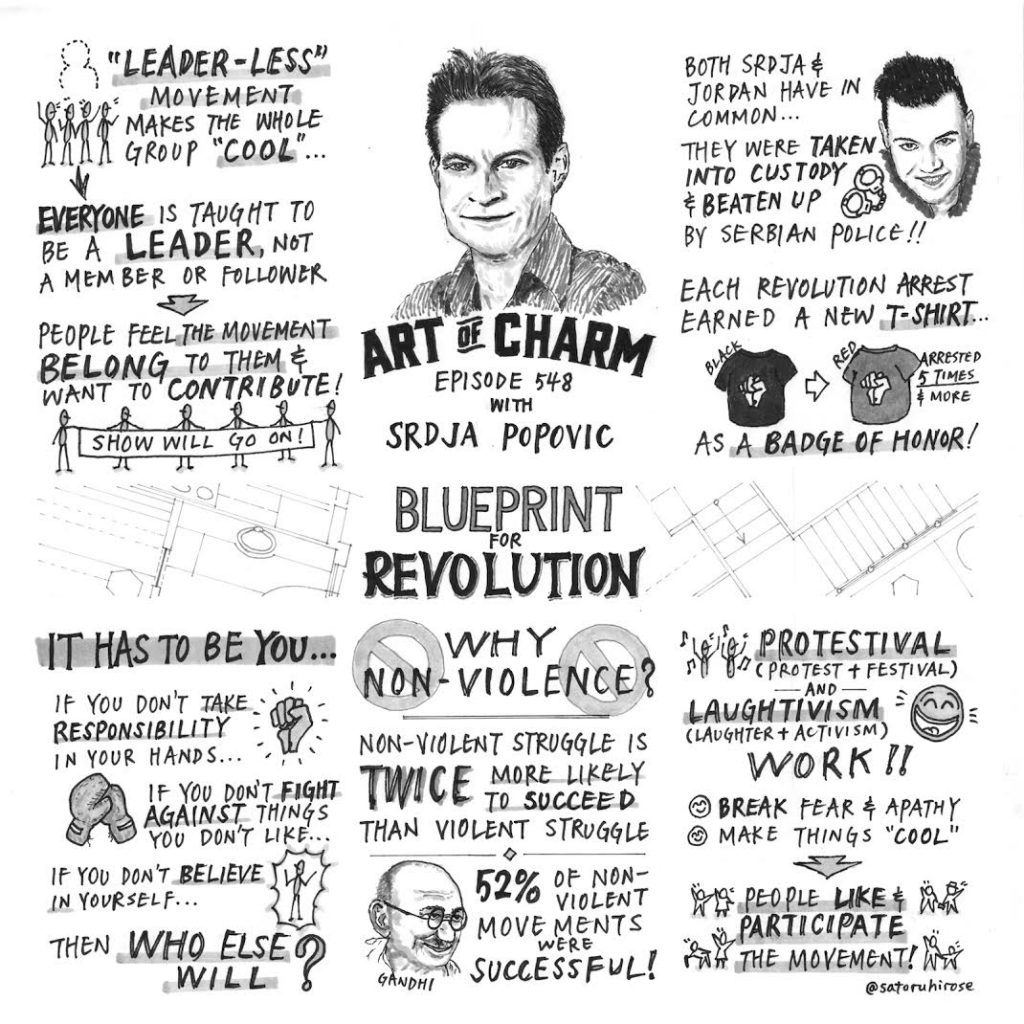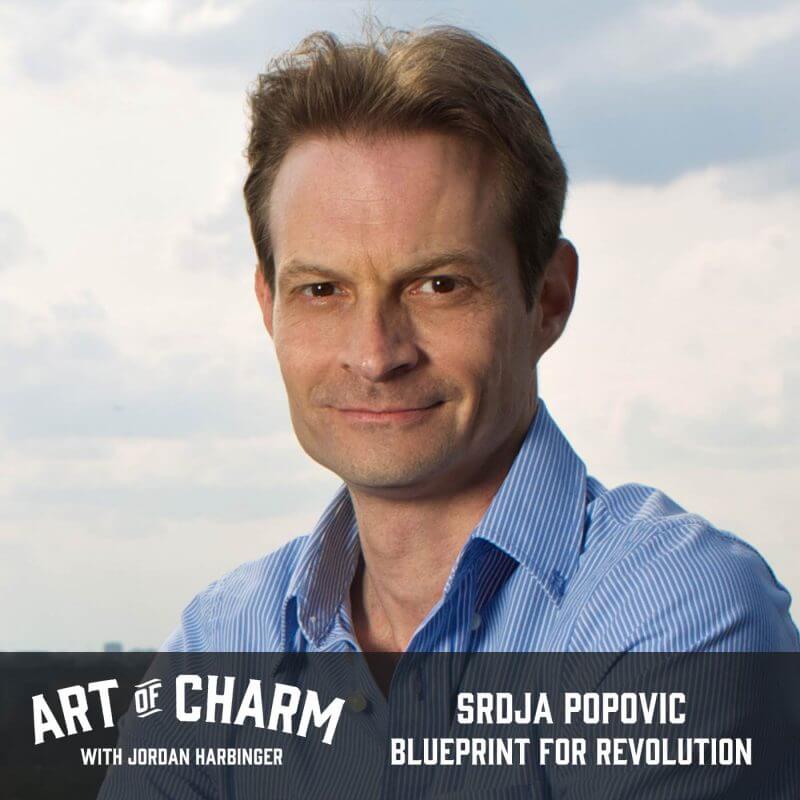Srdja Popovic (@SrdjaPopovic) is the author of Blueprint for Revolution: How to Use Rice Pudding, Lego Men, and Other Nonviolent Techniques to Galvanize Communities, Overthrow Dictators, or Simply Change the World.
The Cheat Sheet:
- What do revolutions and businesses have in common?
- Why nonviolence is more popular (and more effective).
- Why there are no charismatic leaders in the most successful revolutions.
- How to make a revolution cool by using comedy.
- How was ’90s Serbia like Middle Earth in the era of The Lord of The Rings (Hobbits and all)?
- And so much more…
[aoc-subscribe]
Revolution is a lot like business. The only real difference is that, instead of trying to get people to flock en masse to your product or service, you’re rallying them to support your political stance — or at least upset the intolerable status quo. There are techniques that work, and techniques that don’t.
Today’s guest is Srdja Popovic, author of Blueprint for Revolution: How to Use Rice Pudding, Lego Men, and Other Nonviolent Techniques to Galvanize Communities, Overthrow Dictators, or Simply Change the World. He’ll tell us about the psychology behind successful nonviolent activism — used to great effect in the ousting of Serbian dictator Slobodan Milosevic in 2000 — and what Occupy Wall Street could have done differently. Enjoy the show!

More About This Show
While it might seem like Srdja Popovic, author of Blueprint for Revolution: How to Use Rice Pudding, Lego Men, and Other Nonviolent Techniques to Galvanize Communities, Overthrow Dictators, or Simply Change the World plays the part of a professional revolutionary, he’ll say his role is more of a teacher and storyteller who shares his experiences in revolution from the ’90s and 2000s with others engaged in revolution today.
“The only successful revolutions are those revolutions and changes that are coming from within,” Srdja says, “so there can’t be somebody from the outside to tell you what to do.” He’s written his book as a way to lend his expertise in nonviolent opposition if not his direct leadership.
Srdja explains what it was like to come of age in ’90s Serbia, and why revolution was an inevitability for his generation.
“If you were born between ’69 and maybe ’80, you would be entering the ’90s from a very convenient middle class life. Very cool rock music. And then the nasty guy (Slobodan Milosevic) comes in and then immediately everything turns around and people are becoming more nationalistic. And you start being fed with this crazy propaganda that you need to hate people and go to war with them because of their ethnicity. The whole world falls apart, and this is exactly the situation [in which] my generation found itself in the ’90s. From a very convenient world, we ended up in a very nasty world…complete crash of values. Complete crash of economy. Complete crash of perspective. If you [were] in your twenties in that type of environment, you would have only two choices: to fight or to flee.”
Many Americans may find it difficult to understand how thousands of young people could unite to overthrow the government responsible for creating such a scenario — especially when so many can’t be bothered to commit to the mere act of voting to affect change. But he sees the climate of ’90s Serbia as eerily similar to what the United States is experiencing today.
“The national populists are taking over and they’re spilling their poison. And they’re very effective on building on the hatred. I think the real problem we had is that we were living in a relatively happy, though a little bit outdated, socialist state in the ’80s. And then the nasty guys came in and started selling hatred.”
After years of war, anti-intellectualism, and the splintering of Yugoslavia, Srdja believes his generation was forced to ask itself an important question about who would be responsible for turning things around: “If not us, who else?”
Like the Hobbits of Srdja’s favorite series in literature, The Lord of the Rings, he and others of his generation had to take it upon themselves to keep their country safe from the villains, even if they seemed like unlikely protagonists at the beginning.
“If you don’t take the responsibility in your hands, if you don’t fight back against the things you don’t like, if you don’t believe in yourself, then who else will? We understood in ’98, when the movement called Otpor! — which is the backbone of the book and used to be our launching pad…[for our activism], that there would be nobody else to take this ring to Mordor! It has to be us. Yes, we are Hobbits. Yes, we are lazy. Yes, we have big feet. Yes, we like to [lead] laid-back lives. But if we don’t do this, the whole future of our country’s going to be thrown in the darkness.”
Listen to this episode of The Art of Charm to learn more about why the Hobbits of Otpor! chose nonviolent resistance against a very violent regime, the three principles of a successful revolution, why nonviolent ways of protesting are twice as effective as violent protest, how to get people involved in resistance, how to make revolution fun (protestival), what Srdja learned from Harvey Milk about beating the odds, how Otpor! used branding instead of figureheads to make revolution not only cool, but unstoppable, the place of humor in revolution (laughtivism), how revolution in the 21st century differs from revolution in the 20th century, and lots more.
THANKS, SRDJA POPOVIC!
Resources from this episode:
- Blueprint for Revolution: How to Use Rice Pudding, Lego Men, and Other Nonviolent Techniques to Galvanize Communities, Overthrow Dictators, or Simply Change the World by Srdja Popovic and Matthew Miller
- The Centre for Applied Nonviolent Action and Strategies (CANVAS)
- Srdja Popovic talk at TEDxKrakow: How to Topple a Dictator
- Srdja Popovic at Twitter
- Otpor!
- The Lord of the Rings by J.R.R. Tolkien
- Why Civil Resistance Works: The Strategic Logic of Nonviolent Conflict by by Erica Chenoweth and Maria J. Stephan
You’ll also like:
- The Art of Charm Challenge (click here or text 38470 in the US)
- The Art of Charm Bootcamps
- Best of The Art of Charm Podcast
- The Art of Charm Toolbox
- The Art of Charm Toolbox for Women
On your phone? Click here to write us a well-deserved iTunes review and help us outrank the riffraff!
